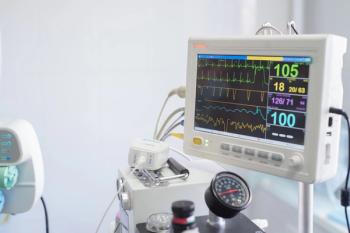
Resectoscopic Myoma Vaporizer
OBJECTIVE: To evaluate a new resectoscopic electrode design intended to vaporize large intrauterine myomate.
OBJECTIVE: To evaluate a new resectoscopic electrode design intended to vaporize large intrauterine myomate.
STUDY DESIGN: To study the vaporizing electrode’s capabilities of destroying myomata on contact using electrical energy (cutting waveform), attempts were made to find the lowest effective power to accomplish the desired effect. Vaporization of myomata was performed in the outpatient surgical center of Cedars-Sinai Medical center during operative hysteroscopy, with the patient under general anesthesia. The procedures were performed on 12 patients presenting with menorrhagia for what intracavitary submucous myomata were discovered at office hysteroscopy, with attempts at settings of from 110-200 W/
RESULTS: Vaporization of myomata readily occurred, with 200 W of pure cutting waveform current the optimal setting.
CONCLUSION: A new grooved ball or grooved cylinder electrode can be used to vaporize portions of intrauterine myomata to facilitate their removal. Advantages of using the vaporizing electrode include significant reduction in the time of the procedure, avoidance of a large number of "chips" of myomata that interfere with the case and safety of the resectoscopic procedure, apparently reduced intraoperative bleeding and intravascular intravasation. (J Reprod Med 1995;40:791-795)
Keywords: myoma, resectoscope.
Introduction
Hysteroscopic management of abnormal uterine bleeding has become an important and request gynecologic procedure.1-3 When submucous myomata are discovered as the etiology of such bleeding, removal of the tumors can be accomplished with the use of the gynecologic resectoscope and electrodes (usually wire loop, cutting electrodes) to morcellate the lesions for removal through the cervix.4 While the procedure is quite successful at removing the tumors, it is often tedious owing to the production of numerous "chip" of tissue that need to be removed when they obscure the view and that make placement of the loop electrode more difficult and dangerous. In addition, resection into the tumors often opens large vessels, resulting in bleeding and/or intravasation of sodium-free dissension fluid.
In recent years the development of a corrugated electrode, the VaporTrode (CIRCON ACMI, Stanford, Connecticut) has been reported in the urologic literature to have the capacity of vaporizing the prostate in cases of prostatic hypertrophy, with dramatic reductions in bleeding, intravasation, duration of surgery and length of time requiring indwelling catheterization.5-7 In those procedures, vaporization of the prostate was produced using this electrode with up to 300 W of current in a pure cut waveform.
Because of the success of the technique for prostatic surgery, the procedure and instrumentation were used in an attempt to vaporize submucous myomata. This paper reports the initial experience for this indication.
Materials and Methods
From January 1994 through April 1995, 12 patients with a complaint of menorrhagia underwent office hysteroscopy, with the finding of submucous myomata that were almost totally intracavitary and measured from 3 to 5 cm in diameter (confirmed by ultrasonic measurements). All patients were then scheduled for resectoscopic surgery at Cedars-Sinai Medical Center, and the surgery was performed as an outpatient procedure under general anesthesia without endotracheal intubation. All patients were given single intravenous doses of broad-spectrum antibiotics (cefotetan, 2g) just prior to surgery. Uterine distension was effected using 3% solution, and the resectoscope used was a standard, continuous-flow, 25 F gynecologic resectoscope with a 12° telescope (CIRCON ACMI). Vaporization was performed using a grooved ball electrode, 2.5 mm in diameter, and a grooved cylinder electrode, 3.0 mm in width (Figure 1). Blood loss was estimated by the amount of discoloration of the effluent liquid collected in the outflow suction bottles, and the discrepancy between inflow volume and outflow volume recorded.
Results
Vaporization of myomata did not occur until the current reached 140 W, and then it was slow and minimally deep until 200 W was reached. The wider vaporizing electrode (3.0-mm cylinder) produced a wider path of vaporization (Figure 2), while the grooved ball electrode (2.5mm) was more precise in incising portions of the myomate (Figure 3). In no case were these chips floating in the endometrial cavity, obscuring the view and requiring a halt to the vaporization in order to remove the loose pieces. The resectoscope was withdrawn from the uterine cavity only to change electrodes or to inert a ring or myoma-grasping forceps (Figure 4) to remove the remaining portions of the morcellated tumor. When a small portion of the myoma remained in the superficial myometrium, the wire loop electrode was pure cutting current at 110 W was used to shave the residual tumor (Figure 5). Because of the lack of chips, the procedures all were significantly faster than with the gynecologic resectoscope and loop electrodes alone.
Fluids in the suction bottles were minimally blood tinged, and all cases were reported as demonstrating estimated blood loss of < 110 mL. The discrepancy between inflow and outflow volumes ranged from zero to 200 mL. In no case was there a significant amount of intravasation of distension fluid.
Discussion
The most frequent problems arising from the hysteroscopic resection of submucous myomata have been blood loss during the procedure, the risk of fluid overload of sodium-free liquids resulting from intravasation of these distension fluids, and the tedious job of stopping the resection numerous times to remove vision-obstruction pieces of the myoma shaved loose by cutting electrodes.
The vaporizing electrode is grooved to utilize the concept of "edge density": the highest concentration of power in an electrode in at the edges. Thus, for example, the three grooves in the vaporizing cylinder provide eight edges through which the current is concentrated to vaporize the cells with which it comes in contact. The bubbles and heat created by vaporization of living cells are readily removed in a continuous-flow system by lower pressure suction on the tubing connected to the outflow port. The use of the vaporizing electrode with high current, as opposed to using a cutting loop electrode, apparently induces greater sealing off of blood vessels, resulting in less introperative bleeding and intravasaton of distension fluids.
In a previous report,4 two patients were found to have leiomyoscarcoma on pathologic examination of the portions of myomata resected hysteroscopically. In neither case was sarcoma suspected from the gross appearance of the lesions. It is mandatory that no myoma be vaporized in its entirety but that substantial portions be retrieved for microscopic examination. Actually, it is faster to use the vaporizing electrode to divide the myoma into large chunks rather than vaporizing the entire tumor. In addition, the speed of performing the procedure is greatly increased as a result of the vaporization of large segments, leaving no chips to interfere with the view and no need to withdraw the resectoscope until the end of the procedure to remove the pieces with forceps.
Although the follow-up period at present is too short for complete confidence in the long-term control of abnormal bleeding, none of the 12 patients thru far have had recurrence of the problem or have required further treatment of any type for it.
Conclusion
As it appears to have done in urology for the prostate, the vaporizing electrode, in combination with higher settings of cutting current, offers a great advantage in the management of submucous myomata. Vaporizing large portions of a myoma results in greater speed, fewer pieces to remove-especially less removal of chips in order to see better-and reduced risks of intraoperative bleeding and intravasation.
A summary of important points in vaporizing submucous myomas is listed in Figure 6. Because of the risk of missing leiomyoscarcoma, no myoma should ever be vaporized totally, but portions should be sent for pathologic examination. Another risk is the very dangerous use of high current settings, a factor that could increase the risk of serious bowel or bladder injury should perforation of the uterus occur. As with other high-technology innovations, use of the vaporizing electrode should be limited to surgeons with experience in operative hysteroscopy.
References:
References
1. Neuwirth RS, Amin HK; Excision of submucous fibroids with hysteroscopic control. Am J Obstet Gynecol 1976:126:95-99
2. Brooks PG, Loffer RD, Serden SP: Resectoscopic removal of symptomatic lesions. J Reprod Med 1989;34:435-437
3. Valle RD: Hysteroscopic removal of submucous leiomyomas. J Gynecol Surg 1990;6:89-86
4. Corson S, Brooks PF: Resectoscopic myomectomy. Fertial Steril 1991;55:1041-1044
5. Babayan RK, Siroky MB, Krane RJ: Transurethral vaporization of the prostate (TUVP): An electrosurgical alternative to laser prostatectomy. Presented at the 12th World Congress on Endourology, St. Louis, Missouri, December 3-6, 1994.
6. Bush IM, Malters E, Bush J: Transurethral vaporization of the prostate (TVP): New horizons. Soc Minimally Invasive Ther (suppl) 1993;2:98
7. Kaplan SA, Te AE: Transurethral electroevaporaton of the prostate (TVP): A novel method for treating men with benign prostatic hyperplasia. Urology 1995;45:566-572
From the Departments of Obstetrics and Gynecology, University of California at Los Angeles School of Medicine and Cedars-Sinai Medical Center, Los Angeles, California.
Dr. Brooks is Clinical Professor, Department of Obstetrics and Gynecology, University of California at Los Angeles School of Medicine, and Attending Physician, Department of Obstetrics and Gynecology, Cedars-Sinai medical Center, Los Angeles, California.
Address reprint requests to: Phillip G. Brooks, M.D., 8631 West Third Street, Suite 510E, Los Angeles, CA 90048.
Journal of Reproductive Medicine
Newsletter
Get the latest clinical updates, case studies, and expert commentary in obstetric and gynecologic care. Sign up now to stay informed.
















